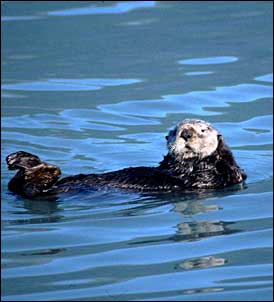
Table of Contents
Print This Page
Email This Page
Email Newsletter
Text-Only Version


Humpback Whales– As baleen feeders, these whales eat mostly plankton and krill. Alaska waters are their primary feeding grounds, where they will consume about a ton of food per day. Fourty feet long and weighing 30-40 tons, these gentle giants spend one-third of their lives migrating from their home in Hawaii or Mexico to their summer home in Alaska.
Gray Whales– Leaving their winter mating grounds in Baja California, the slow-swimming gray whales follow the coastline northward. They pass through our territory during the spring (mid-April through mid-May), migrating to summer feeding areas in the Bering and Chukchi Seas. Gray whales have the longest animal migration route of any mammal- over 10,000 miles.
Orcas– Nicknamed “killer whale” because they sometimes kill whales, orcas are actually the largest member of the dolphine family. They exhibit a highly evolved social structure, and travel in groups called “pods.” Orcas are capable of speeds of 30 mph and feed on fish and other marine mammals using echo-location for capturing their prey.
Steller Sea Lions– Large males weigh up to a ton and females average 650 pounds. Steller sea lions fish at night, hauling out on rocks during the daylight hours. They gather in breeding and bachelor colonies where they sun themselves. Sea lions are noted for their boisterous bellowing.
Sea Otters– The “old man of the sea,” sea otters are the largest member of the weasel family in North America. They float on their backs most of the time, rolling, grooming and diving for their favorite shellfish. Males can weigh up to 100 pounds and consume 25 percent of their weight in food per day.
Harbor Seals– Recognized by its round head and large eyes, this seal is a light-colored animal with dark markings. It is not a social animal. Unable to move well on land, they are well adapted to diving. The can retrieve food from depths up to 600 feet.
Mountain Goats– These hardy animals are right at home on the rock cliffs of Kenai Fjords National Park. They spend their lives on cliffs with a 50 to 65 percent slope, a normal set of steps has a slope of 30 percent. Their split hooves, slab-sidded build and strong front legs make it easy for them to climb sheer mountainsides to avoid their predators.
Other Marine Mammals-Harbor Porpoise
[ Back to ‘Wildlife Guide’ ]